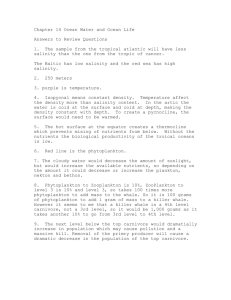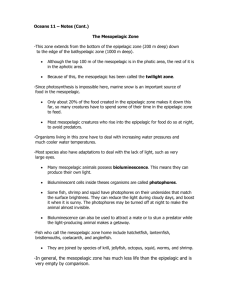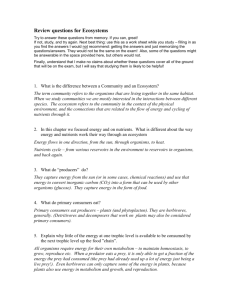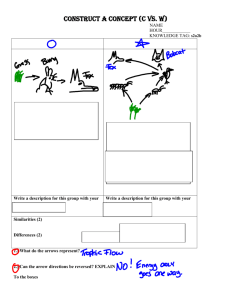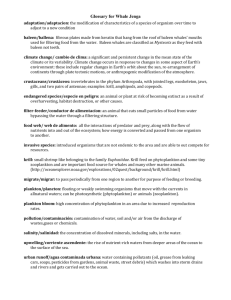Marine Ecosystems
advertisement
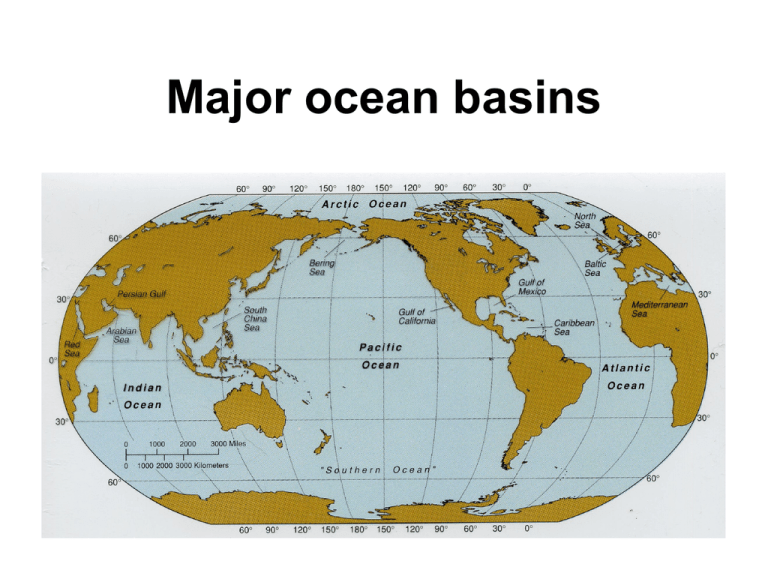
Major ocean basins Patterns of Global Diversity Terrestrial vs. Marine Taxon Marine Terrestrial Phyla 31 14 Classes 85 28 • At the level of phylum and class, diversity is highest in the oceans • However, there is much disagreement at the species level Number of Species Described: Marine = 250,000 Terrestrial = 1.5 million Number of Species Estimated: Marine = 400,000 – 10 million Terrestrial = 4 – 50 million Plankton – can include gametes/eggs Phytoplankton: photosynthetic unicellular algae and bacteria Zooplankton: heterotrophic animals Nekton Organisms that actively swim Benthos Organisms that live on, buried in or associated with the bottom Seaweeds and Plants Invertebrates Vertebrates Divisions of the Oceans Epipelagic (0-200m) Mesopelagic (200-1000m) Bathypelagic (1000-4000) Abyssalpelagic (4000-6000m) Hadalpelagic (6000+m) 3 Main Layers Thermocline • The thermocline is the zone of rapid temperature decline • This is persistent in tropical water, seasonal in temperate water and absent in polar water • The rapid change in temperature produces a rapid change in density – called the pycnocline Upwelling Major Upwelling Regions Coastal Upwelling • Surface water is replaced by cold, nutrient-rich water from depth Equatorial Upwelling• • Currents parallel to the equator are deflected to the right and left In this area of divergence, cold water is upwelled from depth The Epipelagic Epipelagic (0-200m) Mesopelagic (200-1000m) Bathypelagic (1000-4000) Abyssalpelagic (4000-6000m) Hadalpelagic (6000+m) Phytoplankton and Primary Productivity Ocean Food Web Importance of Phytoplankton • Phytoplankton are the major primary producers in the oceans • Responsible for all primary production in pelagic waters and most in coastal waters • They are the foundation of oceanic food webs • Simple food web on chalkboard Primary Production • • • Phytoplankton are efficient producers Can take up dissolved nutrients quickly Can reproduce rapidly – up to 6 generations/day So, what factors control primary production in the ocean? Light Nutrients Grazers Light Productivity varies with depth Above compensation depth Below compensation depth Light Compensation depth can vary in response to phytoplankton blooms Compensation depth can vary geographically and seasonally • Day length • Angle of incidence - Area - Reflection Light and Nutrients • Tropical seas: Never light limited Thermal stratification occurs year-round • Temperate seas: Light limited & no thermal stratification in Fall and Winter Spring bloom with light and stratification • Polar seas: Never nutrient limited Blooms in summer Global patterns of primary production Grazers Euphausids (krill) Copepods • Crustaceans: Large, dominant grazers of larger phytoplankton • Protozoans: Newly appreciated small grazers of very small phytoplankton (nano and pico) • Grazers: Critical link between sun’s energy and epipelagic food webs Predators and their prey The epipelagic is featureless • Lateral line: allows fish to sense vibrations in the water • Light: there is plenty of it so many predators and prey have well developed eyes • Echolocation: used by some cetaceans to locate prey Predator/Prey Interactions Hiding in the blue water Transparency: many zooplankton have some degree of transparency = camouflaged as water Predator/Prey Interactions Hiding in the blue water Countershading: dorsal Bars: break up outline in surface dark, ventral surface dappled light white or silver Predator/Prey Interactions Hiding in the blue water Coloration: silvery sides reflect light to blend in Predator/Prey Interactions Avoiding Capture Schooling: may reduce an individual’s probability of capture during encounter with predator The Arctic Ocean Physical Characteristics • Constant ice, snow, cold temperatures • Drastic seasonal change in photoperiod • High river inputs = stratification • Thick pack ice with low seasonal variation • Surrounded by land • Only 2 outlets Physical Characteristics Polynyas • Occur where swift currents prevent freezing of surface water • Vary in size & permanence • Can be important overwintering place for marine mammals/birds • Also in south Arctic Communities Birds Most are migratory: • Summer in Arctic when relatively warm and lots to eat • Winter elsewhere Arctic Communities Mammals The Southern Ocean Physical Characteristics Antarctic vs. Arctic • • • • • Open to all other oceans No river inputs Pack ice is seasonal Nutrients are high year-round Shelf is narrow and drops steeply • Less drastic seasonal change in photoperiod Southern Ocean Food Web • No seasonal depletion of nutrients so productivity is VERY HIGH in spring and summer • Krill feed on plankton and are critically important to animals at higher tropic levels – everything either eats krill or eats things that eat krill Antarctic Communities Invertebrates: Krill Trapped plankton Antarctic Communities Birds • As in the Arctic, most are migratory to take advantage of seasonal food • Most eat fish, krill and squid Antarctic Communities Birds: Penguins Antarctic Communities Marine Mammals Aphotic Pelagic Communities Physical Characteristics • Largest habitat on earth • Made up of several zones • Abiotic environment is very stable • Always dark, always cold Physical Characteristics Light • Mesopelagic = “Twilight Zone” from 200-1000m • Dim light but no photosynthesis • No primary production • No light in lower zones – except bioluminescence • Tremendous change in pressure with depth (201000+ atm) • Deep sea organisms are adapted to life at high pressure Physical Characteristics Food Animals of the Deep Sea Zooplankton • No Phytoplankton! Fishes • Most are small • Many have photophores Vertical migration • Daytime from 300-500m, at sunset rises to the surface • Depth related to light intensity – deeper during full moons, moves up and down as clouds pass over the moon • Composed of fishes, shrimps, copepods, jellies, squids Adaptations Coloration • In shallower parts of the mesopelagic transparency is common • With depth fishes tend to be black, zooplankton typically orange, red or purple • Red light is absorbed, so red appears the same as black Adaptations Specialized Eyes • In mesopelagic many have large, sensitive eyes • Special eye lenses that can discriminate between natural light and bioluminescence, thereby seeing through counter-illumination camouflage Adaptations Coloration • In mesopelagic camouflage strategies are similar to epipelagic • In lower zones there is no need for counterillumination – most are gray, black or red • Bioluminescence – mesopelagic for counterillumination, deeper for attracting mates/prey Adaptations Bioluminescence • Almost all marine bioluminescence is blue to green – • These wavelengths transmit the furtherest • Most organisms lack visual pigments to absorb other wavelengths Adaptations Bioluminescence Decoy/Surprise Counter Illumination Lures Adaptations Bioluminescence – “Night Vision” • Malacosteid family of fishes (aka Loosejaws) produce and are able to see red light • Wavelengths are almost infrared (barely visible to humans) • The light allows them to see their prey without alerting the prey (or other predators) Deep Sea Benthic Communities • Mud Communities • Chemosynthetic-based – Hydrothermal vents – Whale carcasses Deep Sea Environment • Low and stable temperature 2-5oC (<1oC variation) • High and stable oxygen (thermohaline circulation and low respiration) • At mean depth 4000m pressure is 400 atm = 3 tons/in2 Deep Sea Environment • No light = no photosynthesis • Chemosynthesis at vents • Sparse food • Inputs from small detritus, fecal pellets, marine snow, carcasses of fishes and whales • Deep sea floor is mostly mud, basaltic outcrops at mid-ocean ridges Deep Sea Mud Communities • Organisms are small and at low densities due to limited food • Most have fragile structure due to slow currents and little calcification • Very high species diversity Hydrothermal Vents • Discovered in 1976 • Most organisms were unknown to science • Water is heated by magma deep in sediments and spewed out at seafloor. • Found at both rift and subduction zones Hydrothermal Vents Physical Characteristics • Water is extremely acidic – some snails cannot form CaCO3 shells • Pressure is extreme • Temperature ranges from 2 – 400oC • No sunlight so organisms rely on chemosynthesis for energy • Water contains many compounds, including hydrogen sulfide Hydrothermal Vents Animal Community Hydrothermal Vents • Vents are ephemeral • Change with plate tectonics • Whale carcasses may act as stepping stones between vent communities Whale Carcasses • Severe depletion of whale populations may have profound impacts on deep sea communities • Difficult to evaluate due to lack of historical and contemporary information Coral Distribution The majority of reef building corals occur between 300 north and 300 south latitudes. Coral Distribution • Temperature – nearly all found within 20o isotherm • Depth - do not develop in water deeper than 50-70m • Light – needed by symbiotic algae for photosynthesis • Salinity – intolerant of low salinity • Sedimentation – high levels smother corals • Emergence – can withstand short time in the air, long exposure is lethal Physical Characteristics Stable year-round climate • Few environmental changes throughout the year: • Weak seasonal changes in sunlight • Consistently warm water • Low surface nutrients Physical Characteristics Limits on productivity • Year-round sunlight and heat warms surface water • Warmer water is less dense and so floats on top of the colder water • Persistent thermal stratification prevents nutrient rich bottom water from mixing with warm surface water • Nutrient limitation means few phytoplankton Physical Characteristics Tropical Seas = Marine Deserts Coral Reefs are the exception! Reefs = 1500-5000gC/m2/yr Open ocean = 18-50gC/m2/yr Nutrition • Corals are carnivores that feed on plankton • Open ocean is low in plankton - only enough to satisfy 510% of the food requirements • So, how do corals get enough food? Nutrition • Zooxanthellae are 1o producers • Mostly microscopic and live in tissue of other organisms • Corals provide nutrients in the form of waste products so the zoox can thrive in otherwise nutrient poor water • Zooxanthellae provide the corals with food in the form of sugars produced during photosynthesis • Coral reefs support the most diverse fish communities in the world • What factors are important in maintaining this diversity? Habitat, Competition • Reefs encompass an enormous diversity of structural habitats – both biotic (i.e. corals, algae etc) and abiotic (i.e. caves, crevices, sand) • Habitats also vary with depth and wave exposure World Wide Kelp Distribution Factors Affecting Distribution • Substrate – kelps need hard surfaces on which the holdfast can attach • Light – needed for photosynthesis, kelps are found deeper where the water is clearer • Temperature – kelps need cool water • Nutrients – warm water and low nutrients restrict them from the tropics • Grazing – grazing pressure can create barren areas Kelp Forest Zonation Holdfast Kelp Forest Zonation Midwater Kelp Forest Zonation Canopy Importance of Kelp Forest • Three-dimensional structure provides habitat for a diverse set of organisms • Provides nursery habitat for juvenile rockfish • Harvested as food for abalone farms and for algin (used in ice cream, toothpaste and cosmetics) Estuaries, Salt Marshes and Mangroves Estuary: Physical Characteristics Salinity • Tides – high tide drives salt water further up an estuary, low tide reduces salinity (2 high tides per day, typically) Physical Characteristics Substrate • Most have soft, muddy substrates • Both fresh and salt water inputs carry particles which settle to the bottom Temperature • Smaller volume and larger surface area result in greater variation in water temperature • Freshwater inputs are more variable with season Physical Characteristics Wave Action • Reduced wave action due to small fetch and shallow depth • Currents are caused by tides and river flow Oxygen • There is usually plenty of oxygen in the water • Can vary with temperature and salinity • Substrate is anoxic below the first few cm Salt Marshes • Communities of emergent herbs, grasses and low shrubs rooted in soils alternately inundated and drained by tidal action • Border temperate and subpolar estuaries, protected shores and bays • Dominant intertidal feature on Atlantic coast, minor on Pacific coast Physical Characteristics • Salinity – fluctuates with inputs and tides, can be more extreme than estuaries • Temperature – also show extreme variation, below 0C in winter, above 30C in summer • Substrate – typically mud with high salt content, soil is often anoxic Mangrove Forests Distribution Estimated in 1974 that 60-70% of the world’s tropical and subtropical coastlines are lined with mangroves Physical Characteristics Water Movement • Can only establish themselves in areas with little wave action, so water motion is minimal • Slow water means particles settle out and accumulate on the bottom • Substrate is usually mud • Prop roots further slow water and increase deposits of particles – can increase coast by up to 200m/yr Physical Characteristics Tides • Mangroves are only found in shallow water and intertidal areas • Salt tolerance enables them to out-compete other vascular plants • Tides move salt water further inland, extending their range • Tidal flux moves nutrients into forests • Water movement prevents soil salinity from reaching lethal levels Importance • Nursery ground for many fish and invertebrate species • Stabilize sediment and thus prevent coastal erosion • Sediment trapping reduces the amount that might otherwise smother reefs
